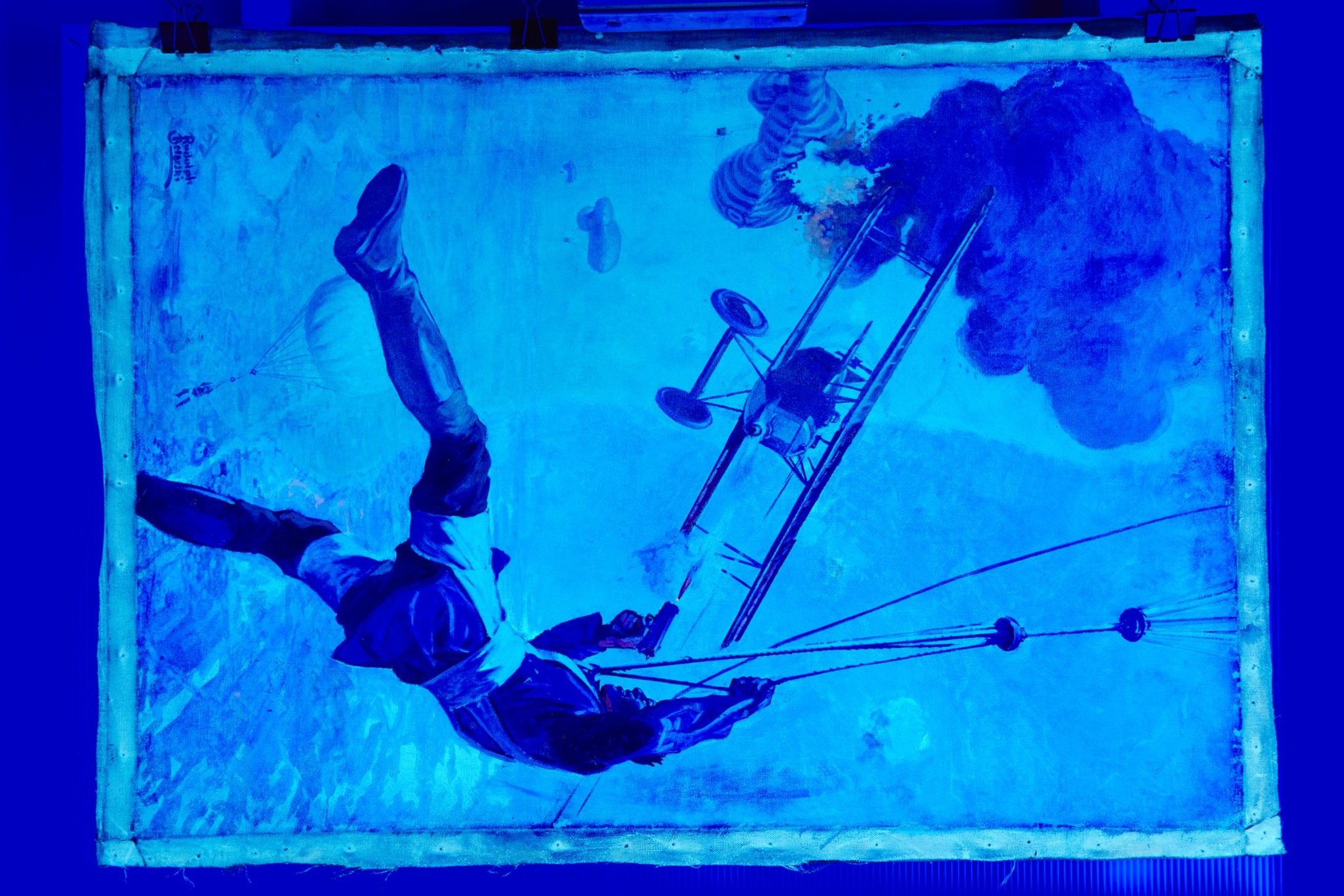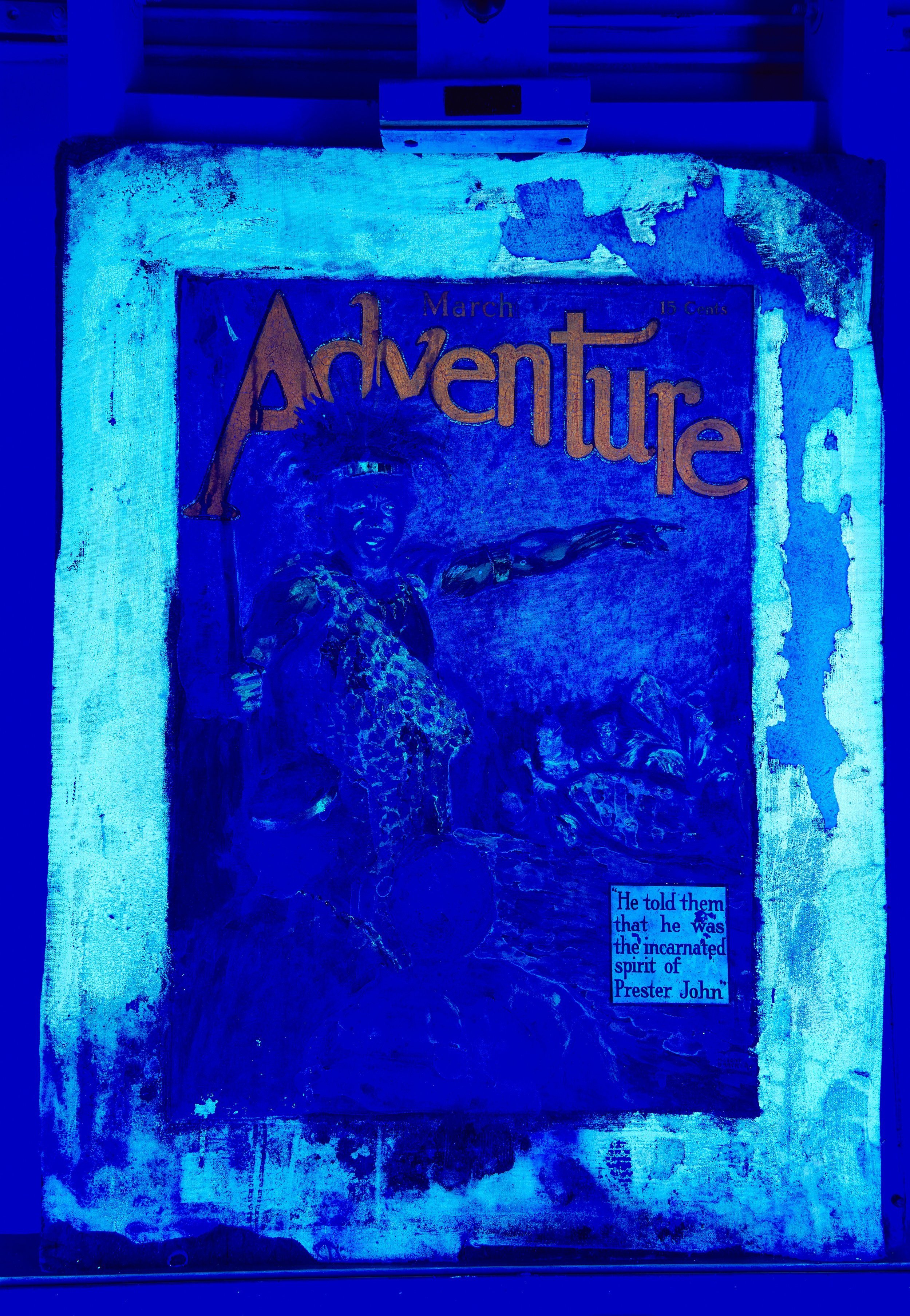Wings, November 1932 before treatment
Adventure "He Told Them That he was the Incarnated Spirit of Prester John", March 1911 before treatment
Wings, November 1932 Book cover
Adventure "He Told Them That he was the Incarnated Spirit of Prester John", March 1911 book cover
An avid pulp art collector, Doug has brought his new acquisitions to The Center for years. We recently had the pleasure to conserve two pulp art paintings for Doug - Wings, November 1932, and Adventure, "He Told Them That he was the Incarnated Spirit of Prester John." March 1911 They are always welcomed by Senior Paintings Conservator Amber Schabdach, who has shared she "absolutely loves working on them as they are fun to look at, and always look amazing once cleaned" These paintings are the original art for the pulp book covers; pulp covers were designed to draw in the reader and are an iconic and collectible part of the science fiction genre.
Wings, November 1932 before treatment, recto
Wings, November 1932, was painted by Rudolph Belarski (1900–1983) and is signed at the lower left. It arrived at The Center as many pulp art paintings do - unstretched. There were stretcher creases along all sides of the painting from being stretched in the past. There were mechanical cracks in the paint layer, with areas of paint loss as well. There were losses at the bottom center, a more considerable loss measuring 1" x .5" in the lower left, and some minor losses and abrasions along the top two inches of the painting.
Wings, November 1932 before treatment, verso
The painting exhibited a layer of natural resin varnish, which had discolored. The varnish was tenacious, and there was surface dirt underneath the varnish layer. Flyspecks were scattered across the painting, and the surface was coated with a moderate layer of grime.
Wings, November 1932 during treatment, with the cleaning line visible
Amber began treatment by surface cleaning to remove the grime and flyspecks. Then, the varnish layer was removed as much as possible, with the appropriate solvents determined after testing.
Wings, November 1932 during treatment, with the cleaning line visible under UV light
The canvas was flattened using moisture and weight techniques and was reinforced at the corners with Japanese tissue and conservation adhesives to offer structural support. The painting was then stretched to a new stretcher, keyed out to provide adequate tension for the canvas.
Wings, November 1932 after painting conservation
Wings, November 1932 after painting conservation under UV light
Wings, November 1932 after treatment verso
Once restretched, the losses were filled and textured using an appropriate conservation grade fill material. Amber then applied an isolating coat of varnish to saturate the paint layer. When dry, inpainting was carried out in areas of loss and abrasion using conservation paints. Lastly, a final coat of varnish was applied to integrate the surface gloss.
Wings, November 1932 after treatment recto
A coroplast backing board was attached to the reverse to provide additional protection.
Adventure "He Told Them That he was the Incarnated Spirit of Prester John" March 1911 was painted by American artist M. Leone Bracker (1885–1937) and is signed at the lower right. Unlike Wings, Adventure was painted on canvas that had been adhered to a composition board. The composition board was slightly warped and appeared concave when viewed from the front. The artist did not paint the outer 3" to 4" of the presentation surface; it only had a ground layer. In this area, an old mat board was adhered to the surface, which also exhibited mold growth.
Adventure, "He Told Them That he was the Incarnated Spirit of Prester John” March 1911 before treatment
Cracks were noted throughout the yellow "Adventure" paint; those cracks appeared secure during the examination. There is a paper addition adhered in the lower right quadrant that has small losses. An area of paint loss measured about 1" x 1" in the lower left corner as well.
Adventure, "He Told Them That he was the Incarnated Spirit of Prester John” March 1911 before treatment, verso
The painting exhibited a layer of natural resin varnish that had discolored. Mold accretions were present in the lower left corner of the image, and the paint showed a moderate layer of surface grime overall.
Adventure, "He Told Them That he was the Incarnated Spirit of Prester John” March 1911 before treatment
Once again, Amber began treatment by surface cleaning to remove the grime. The painting reverse was also cleaned of grime using a soft brush and vacuum. The mold was reduced using appropriate conservation methods and materials, and then, the varnish was removed using the appropriate solvents.
Adventure, "He Told Them That he was the Incarnated Spirit of Prester John” March 1911 under UV light
The painting was then carefully freed from the board using the appropriate conservation techniques, and the excess adhesive was reduced using a scalpel. The canvas deformations were then flattened as best as possible before the canvas was lined to a prepared lining fabric to offer structural support.
Adventure, "He Told Them That he was the Incarnated Spirit of Prester John” after treatment
Amber then stretched the painting to a new stretcher to feature the painted image only. “The Adventure treatment was a little unusual as the canvas was much bigger than the painted area, and there was a paper addition with a quote on it. The unpainted canvas edges were wrapped around back to retain them but not have them be visually disruptive.” Keys were secured in the stretcher, and the stretcher was keyed out to provide adequate tension for the canvas. Once restretched, the losses were filled and textured using an appropriate conservation grade fill material. An isolating coat of varnish was then applied to saturate the paint layer, but with careful consideration. Amber noted, “the paper element had to be covered when varnishing to ensure that it was not also varnished." Once dry, inpainting was carried out in areas of loss and abrasion using conservation paints. A final coat of varnish was applied to integrate the surface gloss.
Adventure, "He Told Them That he was the Incarnated Spirit of Prester John” after treatment verso
Now back with their owner, we are already looking forward to when Doug will bring in his next find!

















